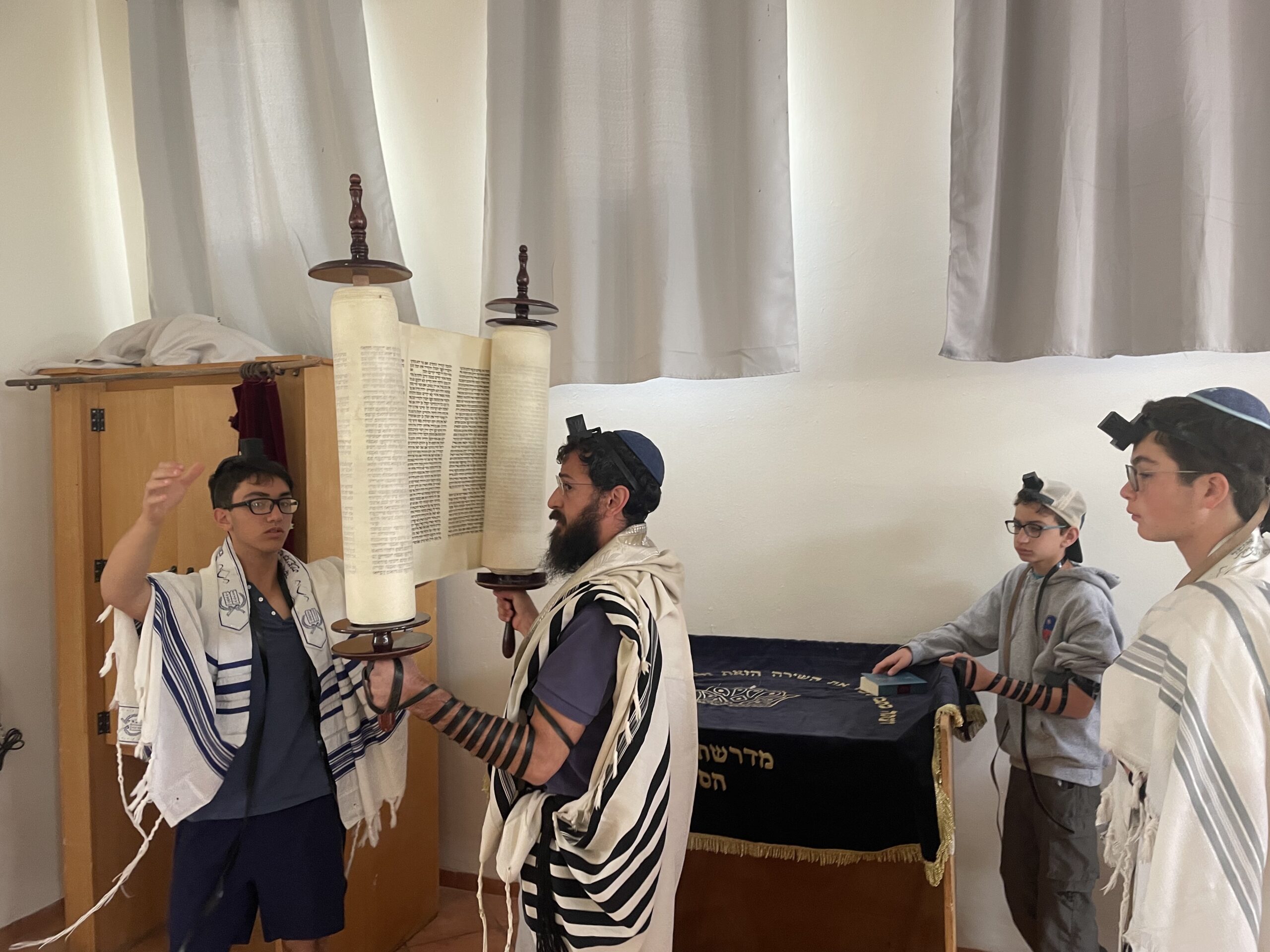
MIDDLE SCHOOL
Judaic Studies – לימודי קודש
At Bi-Cultural Hebrew Academy, our Middle School Judaics curriculum is designed to reflect the belief that Judaic texts and customs are both vibrant and relevant aspects of our daily lives. Through deep and reflective engagement with text and practice, students are inspired to discover understanding, meaning, and enduring connections with their Jewish heritage and traditions. Ultimately, the goal is to mold motivated lifelong learners who are committed to continued spiritual growth for themselves, their communities, and the Jewish People.

Chumash
Our Middle School Chumash curriculum puts into practice all the skills acquired until this point with a focus on the books of Shemot, Vayikra, Bamidbar, and Devarim. Through a text-based course of study providing the linguistic, analytical, and literary skills to become independent learners of traditional texts, students are encouraged to come up with questions on each pasuk and to become thoughtful readers of pesukim. Special emphasis is placed on the types of questions students ask, focusing on word choice, repetition, or ambiguity in a pasuk. The goal is to understand fully what the Torah is trying to teach us so that we can apply it to our daily lives.
Fifth and Sixth grade students spend considerable time sharpening their Rashi skills, as Rashi becomes an indispensable part of their Chumash learning. In Seventh and Eighth grade, more commentaries and tools of parshanut are introduced. At the same time, our study of Chumash provides an opportunity to explore and create deep connections with the values, ideas, and ethics embedded within these texts through narrative study.
Navi
In our Navi curriculum, students gain a meaningful understanding of the early history and challenges of the Jewish people as they study the books of Nevi’im Rishonim (early prophets). The curriculum emphasizes broader textual acquisition as opposed to the skill-focused curriculum in Chumash. Similarly, the emphasis on affective goals and enduring understandings from the narratives of Tanakh is heightened. This curriculum promotes self-reflection of one’s personal Jewish identity and commitment, as well as an appreciation for the role and value the Land of Israel plays in the lives of every Jew – past, present, and future.
Fifth grade Navi continues with the study of Sefer Shoftim, the next book after Sefer Yehoshua. Through our study of Sefer Shoftim, students will explore how leadership of the Jewish people evolved after the death of Yehoshua, the successor of Moshe. Once introduced, this is a theme that continues throughout Nevi’im Rishonim. In Sixth grade, students begin Sefer Shmuel Aleph and in Seventh, Shmuel Bet. Finally, in Eighth grade, students begin studying Sefer Melachim. Thematically, students explore the Ma’agal Ha’hitnahagut, the cycle of behavior that repeats itself throughout these Sefarim. Particular emphasis is placed on the qualities of a Jewish leader and how leaders help people in their time of need.
Mishnah & Gemara
Mishnah (grade 5) and Gemara (grades 6-8) explore diverse topics in Jewish Law, tradition, and ethics with an emphasis on skill acquisition, relevancy and breadth of knowledge. The Talmud curriculum inspires a deep and personal appreciation for how studying these texts ensure that each student may see themselves as an ongoing dynamic link in the chain of tradition, or the Mesorah.
Fifth graders begin their formal study of Torah Sheba’al Peh (abbreviated as TSBP), the Oral Tradition, through the study of Mishnah. Our groundbreaking curriculum offers a survey of key Mishnaic texts throughout the rabbinic corpus. The year begins with an introduction to TSBP, including the key understandings of what an Oral Tradition means and its development throughout Jewish history, beginning at Sinai. They learn that the Mishnah is the foundation for the Gemara, which provides the basis for the halacha we practice today. Students are introduced to the Tana’im, the rabbis of the mishnaic period and authors of the Mishnayot.
In Sixth grade, we introduce Gemara by teaching the unique structures and components of the Talmud, and continue with formal study of tractate Sukkah. In Seventh grade students study tractates Pesachim and Makkot, and in Eighth grade, tractate Sanhedrin is studied. Throughout the course of their Gemara learning, students develop the vocabulary and concepts that support study of TSBP in general. They learn to organize a Mishna into distinct parts, such as speaker, case, halacha, and reason for the halacha. They begin to compare and contrast two different rabbinic texts on the same topic and find textual support for differing rabbinic opinions, all with the goal of becoming self-sufficient, motivated lifelong learners.
Parsha & Chagim
Building upon weekly review of the parsha in Early Childhood and Elementary School, in the Middle School parsha class is focused upon developing deeper understandings and appreciation of the weekly sedrah along with classic and contemporary commentators. The students are exposed to the dynamic stories, vibrant characters, and special halachot in each parsha while focusing and reflecting on meaningful values and ideas that are embedded within the Torah.
At BCHA, we view the Jewish calendar as an opportunity to connect with Hashem as well as with our community. As we learn about the halachot and minhagim pertaining to each holiday, we develop a sense of deep understanding and appreciation for the rhythms and beauty of the chagim. Additionally, there is a focus on appreciating the underlying messages behind each chag, infusing the experiential aspect of their practice with meaning, purpose, and intent.
Hebrew Language
The “Bishvil Ha-Ivrit” – CET curriculum encourages an ongoing and dynamic interaction between content, linguistics, and skill development. The curriculum offers a wide variety of genres – prose and poetry, conversations, interviews, articles, notes, questionnaires and more – providing opportunities to master the four communicative skills – reading, writing, listening and speaking – through a sequential progression of grammar and linguistics. The student’s active linguistic ability is built gradually, allowing for a steady progression toward texts of increasing length and complexity, developing in the student a richer vocabulary, and developing a greater syntactic complexity.
The program offers materials for all levels, from beginner to advanced. The Hebrew Language curriculum is fully aligned and works in concert with the Judaics curriculum, bolstering and enriching our goals of fluency and language acquisition for the subjects of Chumash, Navi, and TSBP. The materials introduce students to Hebrew of all historical periods: biblical, rabbinic, medieval, enlightenment, and modern. Every unit is centered on a theme that is relevant to daily student life while connecting to Israel, Judaism, and the greater world.



